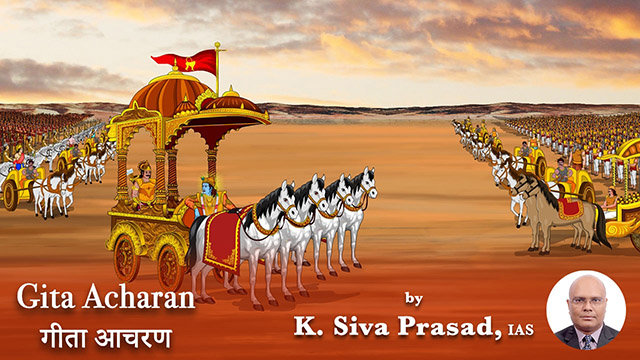
It is generally believed that in the Bhagavad Gita, three paths are prescribed for attaining self realisation. These are 𝙎𝙖𝙣𝙠𝙝𝙮𝙖 𝙮𝙤𝙜𝙖 which is a path of awareness for the intellect oriented, 𝘽𝙝𝙖𝙠𝙩𝙞 𝙮𝙤𝙜𝙖 is a path of surrender for the heart oriented and 𝙆𝙖𝙧𝙢𝙖 𝙮𝙤𝙜𝙖 is the path of action for the mind oriented.
Krishna says that only children, not the wise, speak of 𝙎𝙖𝙣𝙠𝙝𝙮𝙖 and 𝙆𝙖𝙧𝙢𝙖 𝙮𝙤𝙜𝙖 differently. He who is truly established in one obtains fruits of both (5.4). This is an indication that only children or beginners believe these three paths to be separate.
As we progress in the Bhagavad Gita, it becomes clearer that these three paths are not watertight. Instead, clarity appears that 𝙆𝙖𝙧𝙢𝙖 is the foundation for all these paths as each path involves some form of 𝙆𝙖𝙧𝙢𝙖 or another. For awareness, one could begin with reading, serving a master or meditating. In the case of 𝙗𝙝𝙖𝙠𝙩𝙞, it could be ritualistic to begin with but in the end it is seeing HIM even in a thief, enemy as well a donkey.
At the end of the Bhagavad Gita, Krishna concludes about 𝙆𝙖𝙧𝙢𝙖 𝙮𝙤𝙜𝙖 and says that each 𝙠𝙖𝙧𝙢𝙖 is inherently marred by blemishes. This frees us from the guilt and hatred we carry about our 𝙠𝙖𝙧𝙢𝙖𝙨 as our divisive mind keeps labelling them as good and bad. He encourages us to keep performing 𝙨𝙖𝙝𝙖𝙟𝙖𝙢 𝙠𝙖𝙧𝙢𝙖 (natural deed) which is bestowed upon us by the present moment to the best of our abilities.
Whatever may be the path, it is about performing any 𝙠𝙖𝙧𝙢𝙖 realising that ideal 𝙠𝙖𝙧𝙢𝙖 is elusive; performing without attachment; without expecting fruits of action and by dropping hatred as well as desire. Krishna promises that with dedication to 𝙨𝙬𝙖-𝙠𝙖𝙧𝙢𝙖 (one's own deeds) one attains 𝙨𝙞𝙙𝙙𝙝𝙞 (perfection or freedom) as this devotion is nothing but worshipping HIM.
https://epaper.dailyworld.in/Details.aspx?id=157831&boxid=78164&uid=&dat=2024-12-01

